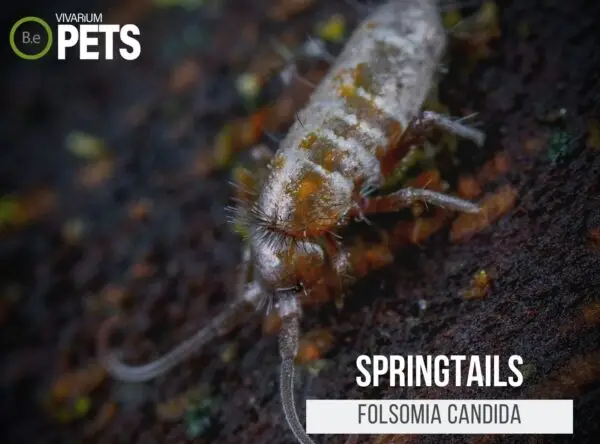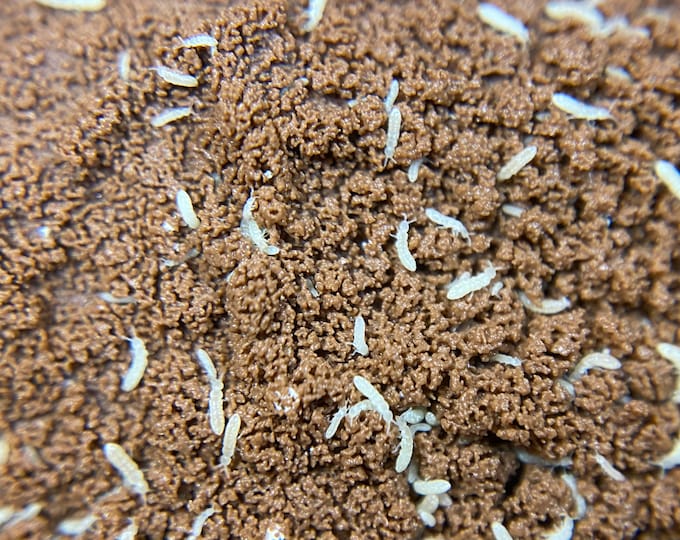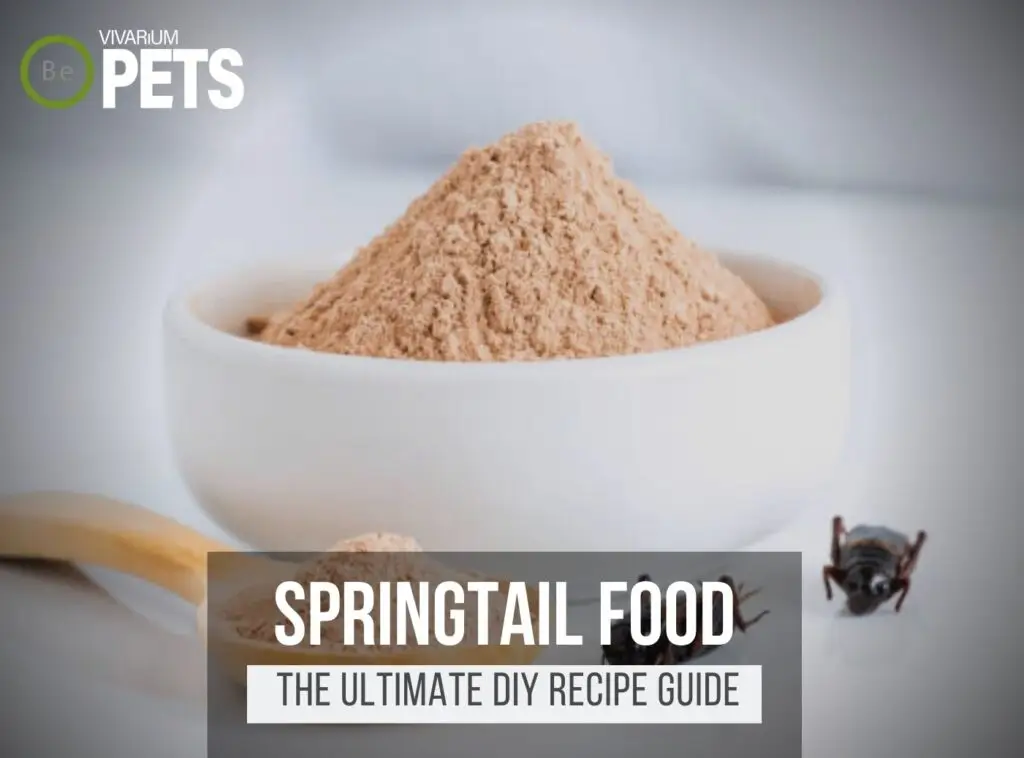Have you ever encountered tiny creatures with six legs hopping around? They might be springtails, also commonly known as Collembola. If you are actively doing anything regarding bioactive vivariums you’ve more than likely at least heard of them.
Springtails have an important role in the environment and make fascinating small terrarium pets. In this guide, we’ll explore how to care for these little creatures and how to safely find them in the wild.
| Characteristics: | |
|---|---|
| Common Name | Springtail, Collembola |
| Family Name | Isotomidae |
| Scientific Name | Folsomia candida |
| Use | Soil aeration, natural pest control |
| Temperament | Non-aggressive |
| Lifespan | 1-2 years |
| Diet | Detritivore |
| Adult Size | 1-3 mm |
| Breeding Type | Egg layer |
| Care Level | Easy |
| Minimum Tank Size | 16oz |
| pH | 6-7.5 |
| Hardness | Soft |
| Temperature | 68-76°F |
What Are Springtails?
Springtails, or Collembola, are tiny, wingless insects that belong to the family Isotomidae.
They can commonly be found in gardens and yards, and the common name “springtail” comes from their jumping ability.
They are scientifically known as Folsomia candida and Collembola is the subclass of this critter’s scientific classification.
What Do They Look Like?
Springtails are small, six-legged arthropods with a hard, segmented exoskeleton that measures between 1 and 3 mm in length.
They come in many different colors including white, brown, black, and even pink. Some species of springtails have bright-colored body segments, while others are plain.
Their head is triangular in shape and they have antennae that can be used to smell and feel their surroundings.
Collembola also has three pairs of legs and two tail-like appendages called furcula, which they use to jump.
Benefits Of Using Springtails
Using Springtails in terrariums is a great way to promote natural pest control, aerate the soil and improve the overall environment.
Collembola consumes decaying plant and animal material, helping to break down the waste, balance the pH level, and to create a healthier environment.
Furthermore, these wingless critters act as a food source for other creatures in the tank, like some species of frogs and salamanders, helping to provide a healthy balance for the entire ecosystem.
In addition to their role in the natural environment, they also provide an important service in human homes. As they feed on mold and fungi, and other pests, They help to naturally control populations of unwanted bugs.
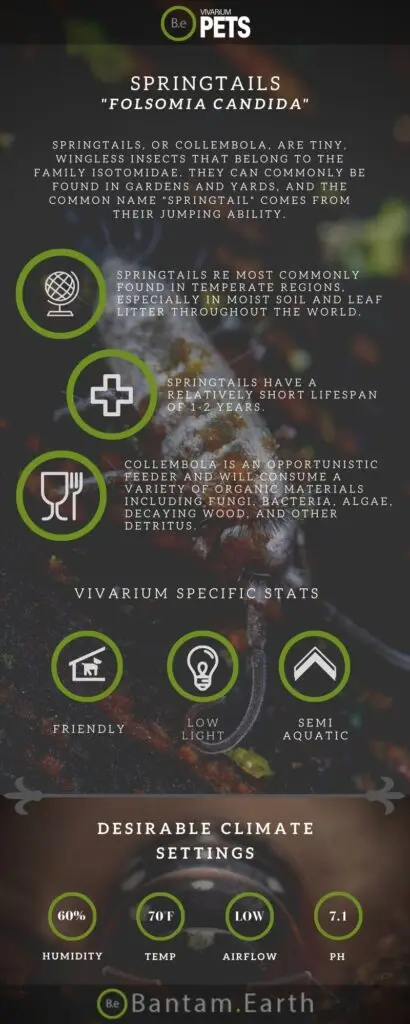

Springtail Facts
Habitat
The typical springtail habitat is dark and damp, with plenty of decaying organic matter to feed on. Collembola first originated in the Carboniferous period, over 300 million years ago.
They are most commonly found in temperate regions, especially in soil and leaf litter throughout the world. They are also able to survive and thrive in aquatic environments.
Diet
Collembola is an opportunistic feeder and will consume a variety of organic materials including fungi, bacteria, algae, decaying wood, and other detritus.
Springtails can also feed on pollen and nectar, and some species may even feed on small insects. Folsomia candida can also feed on algae and bacteria that grow on moist surfaces, such as rocks, tree bark, and decaying leaves.
They consume these organisms using their specially adapted mouthparts, which have tiny bristles to scrape food off surfaces.
Temperament
Springtails are a non-aggressive species of arthropod and have a very calm and curious temperament around humans and other animals.
They have no natural defense mechanisms, so they are often startled and retreat when touched or disturbed.
Collembola will rarely involve themselves in human activity, and therefore pose no threat to people or other animals.
While they can often be seen inside homes, they are harmless, and will not feed on live plants or animals, instead preferring to consume decaying material.
Folsomia candida is also quite timid, and will generally avoid light or perceived hostile environments.
Lifespan
Springtails have a relatively short lifespan of 1-2 years. They have a four-stage life cycle, beginning with the egg phase, followed by larval, pupae, and finally adulthood.
Female collembola will lay their eggs in the substrate, where they will hatch after several weeks. Once they hatch, the larvae will feed on the organic matter until they reach the pupae stage.
After several more weeks, the pupae will become adults and will be capable of reproducing. As adults, they will continue to feed on decaying plant matter until their own lifespan ends.
With good environmental conditions, springtails can live up to 2 years.
Breeding
Springtails mate and reproduce through a process called parthenogenesis, meaning that they mate without the need for a male mate.
Females lay eggs, which hatch after several days. The eggs are then eaten by the larvae, and the larvae molt several times before reaching adulthood.
After the Folsomia candida reaches adulthood, they mate and the cycle continues. In some species of collembola, males will mate with multiple females and share the burden of caring for the young.
Springtails can produce up to five generations of offspring per year, depending on the species and environmental conditions.
Where To Find Springtails
Springtails can be found in almost any moist soil or leaf litter, as well as around decaying plant material. They are also common in mulch, moss, and compost piles.
In order to catch springtails, I like to use a wide-mouth container and a scoop or forceps to take samples of soil or leaf litter that contain the small insects. When handling springtails, it is important to be careful and make sure they don’t escape.
Once the target sample is collected, transfer it to a clean, dry container and make sure the top is sealed tightly. If not being used immediately, the sample can be stored in a refrigerator at about 50°F for up to a week.
If you’d rather buy springtails (like I mostly tend to do these days), click the image below to learn more about the current price and other relative info about this animal.
Springtail Care
Caring for Springtails is an easy process. Provide them with a moist soil substrate and offer a variety of organic matter for them to eat, such as decaying plant material, fungi, and other organic material.
Springtails prefer a warm, moist environment and a neutral pH. Maintain humidity levels between 40-50% and keep the temperature at around room temperature.
Monitor the environment regularly and remove any dead or decaying matter to keep the tank clean.
Tank Requirements
The perfect tank for your Springtails should include the right vivarium type, water parameters, temperature, and substrate.
The best type of tank is a tropical terrarium that provides a moist and humid environment, with an optimal pH level between 6 and 7.5.
For optimal water hardness levels, keep the tank at a softer level and ensure adequate aeration. The ideal temperature of the vivarium should be around 68 and 76°F.
A damp, loose soil substrate such as coco coir should serve as the suggested substrate and it should be kept slightly moist to provide the best conditions.
Lastly, low-intensity lighting is sufficient for springtails as it should stimulate natural behavior.
How To Culture Springtails
Are you looking for a fun, easy way to culture springtails? This step-by-step guide will provide you with the necessary information to ensure that your springtails are happy, healthy, and thriving.
From providing a suitable environment to monitoring the breeding process, this guide will help you to successfully cultivate springtails. So, let's get started!
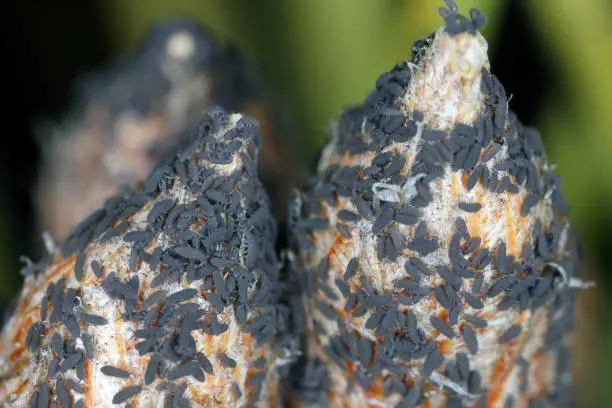

Materials:
Steps to a successful springtail culture
Springtail Food
Springtails are detrivores, meaning they feed mainly on decaying plant matter. Additionally, you can provide them with a few other food sources such as fungi, fruits, and vegetables.
Here are some foods that you can feed your springtails:
- Decaying Plant Matter (Leaf Litter, Compost, etc)
- Fruits (Berries, Apples, etc)
- Vegetables (Carrots, Cabbage, etc)
- Fungi (Mushrooms, Yeast, etc)
If you’re more of an avid hobbyist like myself, be sure to check out my ultimate DIY Springtail food guide. I give a more in-depth explanation of the best foods and my personal favorite recipe.
Springtail Alternatives
Springtails are beneficial to keep around and do make the ideal terrarium clean-up crew. Other beneficial organisms can be kept with springtails as tankmates or used alternatively to achieve similar effects.
Earthworms, for example, are great for aeration, improving soil structure, and adding additional nutrients and oxygen to the soil.
Isopods, also known as woodlouse, are also great for breaking down plant matter and aerating the soil.
Slugs and snails can also be good tankmates for springtails, as they can help to break down and process decaying matter, as well as provide food for the springtails.
All of these animals can be kept with springtails and can help create a natural, self-sustaining cycle in which the presence of one organism benefits all of the other animals and plants as well.
Conclusion
Springtails, or Collembola, are small but important creatures in our ecosystem. If you want to provide a home for these animals or catch them in the wild, understanding their needs and how to safely care for them is essential.
With the right tips, you can become a responsible springtail caretaker and make a positive difference in their lives!
Frequently Asked Questions
There’s no difference, These are two common names referring to the same species of springtail, Folsomia candida. Sometimes hobbyists will refer to one or the other as Collembola sp. but Collembola is a subclass, not a binomial species name.
It takes approximately two weeks for a springtail culture to become established in a suitable habitat.
It takes springtails about 1–2 weeks to reproduce.
The best substrate for springtails is a mix of two parts coco coir soil, one part peat moss, and one part vermiculite.
Yes, you can breed springtails without charcoal. However, adding a bit of activated charcoal or other carbon–rich material helps create the ideal substrate for springtail breeding.
Charcoal provides springtails with an important nutrient, called humic acid, which helps them digest their food more efficiently. It also helps to promote beneficial bacteria in the springtail‘s gut that can help break down and absorb food more efficiently. Charcoal can also be used as a filter to help remove toxins and impurities from their environment.
No, springtails are not harmful to humans. They are tiny insects that feed on decaying plant matter and fungi, making them beneficial for gardens and composting. They do not bite humans or animals, and they do not spread diseases.
No, springtails do not damage your home. They do not feed on structural materials, and they are not considered pests.
Collembola are not insects because they have different characteristics and body types than insects. They have six legs instead of the typical three pairs that insects have, and their body is segmented in segments of three instead of the typical three–segmented bodies of insects.
Collembola is a small insect that feeds on decaying organic matter and helps with decomposition.
No, Collembola are not mites. Collembola is a small, wingless critter that belongs to the class Entognatha. Mites are arachnids and are not insects.
Here is a list of ways you can easily score some free springtails:
1. Find them outdoors in leaf litter, logs, and soil
2. Collect rainwater in a bucket and leave it overnight
3. Use a moist substrate to lure springtails
4. Buy a culture online or from a pet store
5. Collect some from a friend’s tank or terrarium
6. Construct a DIY springtail breeding habitat
7. Utilize natural alternatives to attract springtails
You should start with at least 50 springtails to begin a culture.
